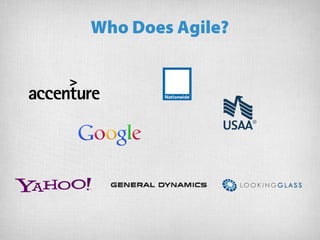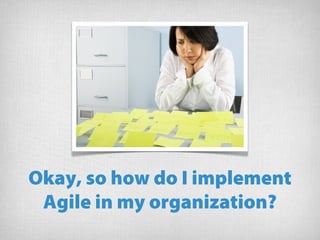Practical Implementation of Agile Methodologies
- 1. Practical Implementation of Agile Methodologies of Agile Methodologies
- 2. About Me • Jessie Link • Senior Manager, Software Development at Lookingglass Cyber Solutions • 12 years experience doing software development • Certified Scrum Master, PMP • Agile Enthusiast • Served 6 years USAF Hello!Hello!
- 3. Should I Stay or Should I Go? What this presentation contains: • Discussion of how to implement agile practices in your organization • How to refine/improve your agile techniques • Real world examples of agile in practice This is not for you if: •You are an agile expert already •You expect to learn about Scrum for the first time •You realize you’re in the wrong session
- 4. The Basics
- 5. Agile Manifesto • Individuals and interactions over processes and tools • Working software over comprehensive documentation • Customer collaboration over contract negotiation • Responding to change over following a plan * http://agilemanifesto.org/
- 6. Types of Agile Methods * http://www.versionone.com/state_of_agile_development_survey/11/
- 7. What can Agile do for you? Benefits of Agile: • Faster time to delivery • QA involved up front • Flexible to fit your needs • Highly disciplined
- 9. Okay, so how do I implement Agile in my organization?
- 10. The Wrong Way Hey team!Hey team! YesYes boss?boss? Did you enjoy that 2Did you enjoy that 2 day Scrum Masterday Scrum Master class I sent you toclass I sent you to last week?last week? Sure.Sure. So you’re allSo you’re all experts at agileexperts at agile now, right?now, right? Uhhh.....Uhhh..... Glad to hear! I can’tGlad to hear! I can’t wait to see howwait to see how productivity jumpsproductivity jumps 100% by next week.100% by next week. Wait aWait a sec.....sec..... So, where’s yourSo, where’s your burndown chart? Andburndown chart? And your backlog? Whenyour backlog? When can I see the newcan I see the new software?software? Burndown chart? Backlog?Burndown chart? Backlog? Um... does anyoneUm... does anyone remember how to do those?remember how to do those? Where’s that binder theWhere’s that binder the instructor gave us.....instructor gave us..... AGILE DOESN’T HAPPEN OVERNIGHTAGILE DOESN’T HAPPEN OVERNIGHT
- 11. Be Agile About Going Agile • Agile takes time to put into placeImplementing Agile is an incremental processNot all agile practices are created equalSwitching a team to Agile is a lot like standing up a team from scratch
- 12. FormingForming StormingStorming NormingNormingPerformingPerforming Tuckman’s Stages of Team Development of Team Development
- 13. Forming Stage • Team comes together - the “getting to know you” stage • Team may be motivated but are usually relatively uninformed of the issues and objectives of the team • People tend to avoid conflict in this stage
- 14. Things to focus on in Forming Take on a Teaching Role
- 15. Things to focus on in Forming Observe Observe Observe
- 16. Things to focus on in Forming Implement Daily Stand Up Cadence!
- 17. Things to focus on in Forming Eliminate the Tower of Babel Hello Hola Moni Halito Hej Hallo Ciao Hai Bonjour
- 18. Things to focus on in Forming Choose Your Weapons
- 19. Things to focus on in Forming Key Team Members • This is Robb • Every team should have a Robb • You also need: • Scrum Master • Product Owner • Test Lead
- 20. Tuckman’s Stages of Team Development of Team Development FormingForming StormingStorming NormingNormingPerformingPerforming
- 21. Storming Stage • This stage involves conflict • Team will challenge each other’s ideas and perspectives - including yours • This is normal - it’s part of the team figuring out how they will work together, what problems they want to solve. • Most risky stage.
- 22. Things to focus on in Storming Take on a Commanding Role
- 23. Things to focus on in Storming Step 1: Implement Metrics Step 2: Go ahead and completely ignore them.
- 24. Things to focus on in Storming Stay the Course
- 25. Things to focus on in Storming There Are No Sacred Cows Implement Retrospectives
- 26. Tuckman’s Stages of Team Development of Team Development FormingForming StormingStorming NormingNormingPerformingPerforming
- 27. Norming Stage • Team has one goal • Team members willing to put their own ideas aside for the greater good of the team • All team members take responsibility for success of team goals
- 28. Things to focus on in Norming Take on a Coaching Role
- 29. Things to focus on in Norming Metrics Hooray!
- 30. Things to focus on in Norming Predictability over Speed
- 31. Tuckman’s Stages of Team Development of Team Development FormingForming StormingStorming NormingNormingPerformingPerforming
- 32. Performing Stage • High performing • Team is autonomous and self-directing • Team is motivated and knowledgeable • Conflict is easy handled within team • Best. Stage. Ever. (Assuming you can reach it)
- 33. Things to focus on in Performing Be an invisible presence at stand up
- 34. Things to focus on in Performing Gentle Course Corrections
- 35. Things to focus on in Performing Always Keep Improving
- 36. Things to focus on in Performing Sit Back and Enjoy the Agile Goodness
- 37. Conclusion
- 38. Remember • Agile does not happen overnight • Be disciplined enough to stick to the processes you have • Be flexible enough to know when to change the processes that aren’t working for you • Don’t be scared of conflict - this is a normal part of team evolution and transition into Agile • Know when to apply and emphasize each process or technique as your team progresses through the stages of Team Development
- 39. Always Be Learning • Conferences • Meetups • http://www.meetup.com/DC-Scrum/ • Training • Books • “The Agile Samurai” by Jonathan Rasmusson (http://pragprog.com/book/jtrap/the-agile-samurai) • Other agile practitioners
- 40. Thank You! • Please come chat with me afterwards • jlink555@gmail.com • Lookingglass is hiring! • Software developers • Cyber analysts • UI/UX designers • www.lgscout.com Goodbye!Goodbye!
Editor's Notes
- Official session description: “Are you familiar with Agile concepts such as Scrum, but unsure how to actually put it into practice? Have you tried to start an agile team but stalled out of the gate after a month or so? High performing agile teams don’t just happen overnight – it takes discipline and a well thought out plan of attack to slowly introduce and integrate good agile practices into your team’s daily workflow. This session will focus on not only how to start the agile transformation, but how to keep iterating and improving over time to achieve long term success.”
- If Agile is a philosophy or a mindset, then let’s talk about the different frameworks available that help you realize that philosophy. Each methodology has its strengths and weaknesses. Scrum is most popular, so that’s what I’ll focus on
- Agile has been shown to work at companies both large and small. It has also been known to fail at companies large and small... how do we avoid that fate?
- I know this sounds like a funny example, but this actually happened to a team I know.
- If you can implement every single agile practice on day 1, more power to you. But I believe that there are some practices that are more important than others, and that a phased approach to slowly adding in more process and rigor is the best way to go
- Bruce Tuckman’s stages of team development, 1965 phases are all necessary and inevitable in order for the team to grow, to face up to challenges, to tackle problems, to find solutions, to plan work, and to deliver results.
- This stage is where you will be teaching the rest of your company about Agile processes. Note: I said company, not just team. It is important that you educate not just your team but the managers as well about what you’re trying to accomplish here.
- Observe - be like Jane Goodall
- What is daily standup? “What did you do yesterday, what did you do today, is there anything blocking your progress?” 15 minutes or less Cadence is key - Scrum is all about rhythm
- Get them speaking the same language. Define “done”. Define key terms such as “technical debt” - tell story of LG team and how no one could understand why code was having trouble
- This is the stage where you need to decide which tools you need to do Agile. Are you a remote team? Are you co-located? That will influence which solutions will work best for you.
- Key team members: Coach, Scrum Master, QA, Product Owner In Forming, you should be working together to lay groundwork for rest of the team to transition
- Some teams never get away from this stage.
- In Storming, you will need to be a bit more dictative - you will need to push people to do things, you will need to work with their boss at times to make sure they are compliant Daily Stand Up is your best friendThis is your best opportunity to correct the team on best practices
- You want to start collecting metrics. However, because you are still storming, those metrics will be too all over the place to have much value at first.
- Theme: the team may challenge you, but stand fast to the processes you believe in
- If you can’t explain why you’re doing a process, then you shouldn’t be doing it If something isn’t working for the team and is preventing you from moving forward, you need to change it This is where the retrospective is key <-- most important thing you will do (explain retrospectives briefly) There are techniques to help you with retrospectives - may feel awkward at first
- When you are in norming, you should be able to start gleaning lots of value from your metrics. You can begin to do predictive planning here. Stories about the power of metrics
- The power of agile is hitting the target everytime, versus having wild variations in ability to produce. -- The story of how my manager tried to set performance goals for me based on speed of delivery - You want to hit a pace that allows you to accomplish quality. Focusing just on speed can lead to defects and technical debt that kills you later on, if you’re not careful
- Hard to get to, hard to maintain
- At this stage, the team should understand Agile practices and will be self-directedDaily Stand Up should run itself Team should feel like they are reporting to each other, not to you
- Small changes, not large. You are just refining your process
- Want to stay in Performing? Acknowledge that you can always do better. Always be re-evaluating where you are as a team, especially emotionally. Sprint retrospectives are a great way to keep your finger on the pulse of the team, and to ensure you stay in the performing stage
- Congrats, you’ve done it! Now, think about ways to spread the agile goodness. Look at ways that Agile might help other teams, or even management
- Be agile about your OWN agile knowledge Always be looking for ways to improve your agile kung fu







































